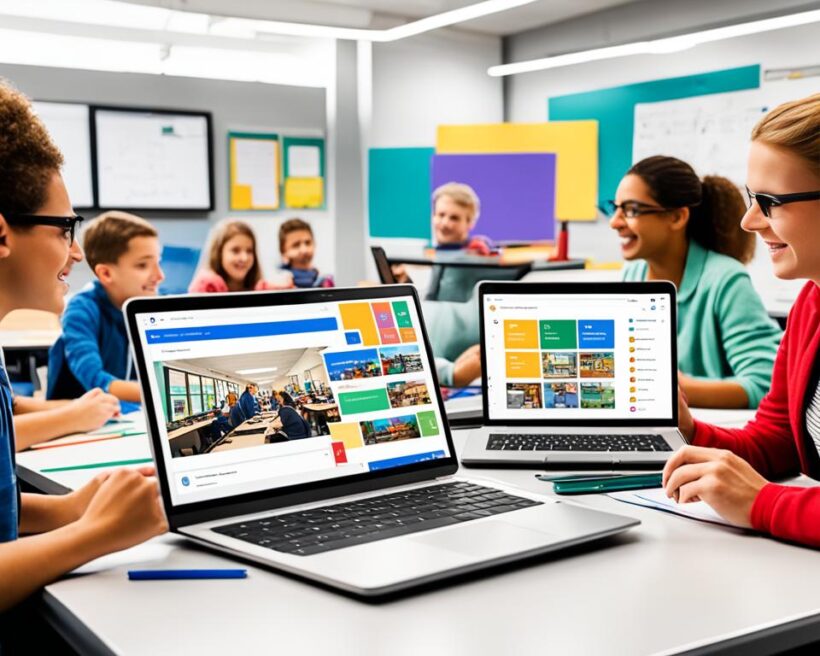Did you know that Google Classroom is the go-to online learning platform and remote education tool for millions of teachers and students worldwide? With its virtual classroom capabilities and efficient features, Google Classroom has revolutionized the way educators manage their classes and interact with students.
Key Takeaways:
- Google Classroom is a popular online learning platform used by teachers and students globally.
- It offers a streamlined way for teachers to manage classes, distribute assignments, and provide feedback.
- Google Classroom integrates with other G Suite for Education tools, enhancing digital collaboration.
- Teachers can optimize their use of Google Classroom with tips and tricks for effective online teaching.
- By utilizing Google Classroom, educators can create organized and engaging virtual classrooms for remote education.
What is Google Classroom?
Google Classroom is an innovative education technology platform that revolutionizes the way teachers and students interact in the digital age. As part of the G Suite for Education, Google Classroom seamlessly integrates with various Google Workspace tools to provide a comprehensive and user-friendly learning environment. Designed to facilitate paperless sharing and digital collaboration, Google Classroom streamlines class organization and enhances communication between teachers and students.
By leveraging Google Classroom, teachers can effortlessly manage class materials, distribute assignments, and share resources with students. The platform offers a centralized hub where teachers can create and organize classes, making it easy to access course materials and assignments. The ability to distribute assignments digitally eliminates the need for physical copy handouts, reducing paper waste and promoting eco-friendly practices.
Google Classroom facilitates seamless digital collaboration by allowing students to submit assignments online. Teachers can review and provide timely feedback, fostering interactive learning experiences. Additionally, the platform promotes effective communication between teachers and students, enabling them to engage in meaningful discussions and address queries promptly.
Google Classroom offers a paperless and collaborative learning environment, empowering educators to leverage technology for enhanced class organization and communication.
Furthermore, Google Classroom supports educators in administering assessments and tracking student progress. With features like automatic grading and data analytics, teachers can efficiently evaluate student performance and gain valuable insights to inform their instruction.
Key Features of Google Classroom:
- Streamlined organization of class materials and assignments
- Paperless sharing of resources and course materials
- Seamless digital collaboration and feedback
- Efficient administration of assessments and tracking student progress
Google Classroom is accessible to anyone with a personal Google account, making it widely used by teachers, students, administrators, and homeschoolers alike. Its intuitive interface, coupled with its integration with other Google tools, ensures a seamless experience for users.
Take advantage of Google Classroom’s powerful features and transform your classroom into a digital, collaborative, and engaging learning environment.
| Benefits of Google Classroom | Examples of Use |
|---|---|
| Streamlined class organization | Centralized hub for assignments and resources |
| Efficient assignment distribution | Digital submission and grading of assignments |
| Enhanced communication | Real-time discussions and feedback |
| Collaborative learning | Group projects and shared documents |
How can Google Classroom support teaching and learning?
Google Classroom offers a variety of features that can greatly support teachers in effectively managing their classes and enhancing the learning experience for their students.
Streamline Class Management
With Google Classroom, teachers can easily assign and collect assignments, eliminating the need for physical handouts and paper submissions. This streamlined process saves time and ensures that assignments are organized digitally, making it easier to keep track of student progress.
Digital Organization
Google Classroom serves as a centralized hub where teachers can distribute course materials, such as readings, presentations, and videos, to their students. This eliminates the need for physical copies and allows students to access resources anytime, anywhere. Teachers can create folders and subfolders within Google Drive, making it easy to organize and locate specific materials.
Assignment Distribution
Teachers can distribute assignments through Google Classroom, ensuring that each student receives the necessary materials. This eliminates the chances of students misplacing or forgetting about assignments and allows teachers to set due dates and reminders, keeping students on track.
Communication
Google Classroom facilitates seamless communication between teachers and students. Teachers can post announcements, share important information, and engage in discussions with the entire class or individual students. Additionally, students can ask questions and seek clarification on assignments, fostering a supportive and interactive learning environment.
Timely Feedback
Google Classroom provides a platform for teachers to provide timely feedback on assignments and assessments. Teachers can use Google Forms for auto-graded quizzes, enabling immediate feedback for students. This supports student learning by giving them a clear understanding of their strengths and areas for improvement.
Overall, Google Classroom empowers teachers to create a digital, organized, and efficient learning environment. By utilizing its features, educators can streamline class management, enhance digital organization, distribute assignments seamlessly, communicate effectively, and provide timely feedback, ultimately fostering a productive and engaging learning experience for their students.
Tips and Tricks for Using Google Classroom Effectively
To make the most of Google Classroom, educators can follow various tips and tricks. Here are some strategies to optimize your Google Classroom experience:
1. Assignment Numbering: Numbering assignments can help you keep your files organized and ensure easy navigation within Google Drive.
2. Using Topics: Utilize the “Topics” feature in Google Classroom to categorize assignments based on subjects, units, or topics. This allows students to easily locate specific assignments.
3. Creating a Class Template: Save time when setting up new classes by creating a class template that includes schedule, class rules, and basic resources. You can easily duplicate this template for each new class.
4. Providing Direct Links to Assignments: Include direct links to assignments in your class announcements or instructions. This helps students navigate directly to the assigned task without searching through multiple folders.
5. Utilizing Private Comments: Engage in meaningful feedback and conversations with individual students using the “Private Comments” feature. Provide personalized guidance and address specific concerns.
Implementing these Google Classroom tips can enhance organization, communication, and student engagement in your virtual classroom.
Example of Assignment Numbering in Google Classroom:
| Assignment Number | Task | Due Date |
|---|---|---|
| 1. | Read Chapter 1 | September 10, 2022 |
| 2. | Complete Quiz 1 | September 15, 2022 |
| 3. | Research Project Proposal | September 20, 2022 |
By implementing these tips, educators can make the most of Google Classroom’s features and enhance their teaching experience with improved organization, communication, and student engagement.
Conclusion
Google Classroom is a powerful tool for educators, providing a wealth of features and functionalities that enhance online education and remote learning. By incorporating this technology into their teaching practices, educators can optimize their teaching process and create a seamless learning experience for their students.
One of the key advantages of Google Classroom is its user-friendly interface, making it easy for teachers to navigate and utilize the platform effectively. The integration with other Google tools, such as Docs, Drive, Meet, and Calendar, further enhances the experience by allowing seamless organization and distribution of assignments and resources.
Additionally, the ability of Google Classroom to provide timely feedback to students is invaluable. With the use of Google Forms for auto-graded quizzes and the option for private comments, teachers can engage in meaningful conversations with their students, ensuring personalized guidance and support.
In the era of digital education, Google Classroom has emerged as a valuable resource for educators, enabling them to create engaging and organized virtual classrooms. With its comprehensive features and seamless integration, Google Classroom continues to revolutionize education technology and empower teachers in the digital age.
FAQ
What is Google Classroom?
Google Classroom is an online learning platform and remote education tool. It is part of G Suite for Education and serves as a cloud-based learning management system. The platform allows teachers to streamline class management, distribute assignments and course materials digitally, communicate with students, and provide timely feedback on assignments and assessments.
How can Google Classroom support teaching and learning?
Google Classroom offers several features that support teachers in managing their classes effectively. Teachers can streamline class management tasks such as assigning and collecting assignments, distributing course materials, and communicating with students. The platform integrates with other Google tools like Docs, Drive, Meet, and Calendar, making it easy to organize and distribute assignments. Teachers can provide timely feedback on assignments and assessments using Google Forms for auto-graded quizzes. Overall, Google Classroom helps teachers create a digital, organized, and efficient learning environment for their students.
What are some tips and tricks for using Google Classroom effectively?
To make the most of Google Classroom, educators can follow various tips and tricks. Numbering assignments helps organize files and keep Google Drive tidy. Using topics helps organize assignments for easy access. Creating a class template saves time when setting up new classes. Providing direct links to assignments helps students navigate easily. Utilizing private comments allows for meaningful feedback and conversations with students. These tips can enhance the overall Google Classroom experience for both teachers and students.
How can Google Classroom enhance online education and remote learning?
Google Classroom is a powerful tool for educators, offering a wide range of features and functionalities to enhance online education and remote learning. By following the tips and tricks mentioned above, teachers can make the most of this platform and streamline their teaching process. Google Classroom’s user-friendly interface, integration with other Google tools, and ability to provide timely feedback make it a valuable resource for educators in the digital age. With Google Classroom, teachers can create engaging and organized virtual classrooms, providing a seamless learning experience for their students.






